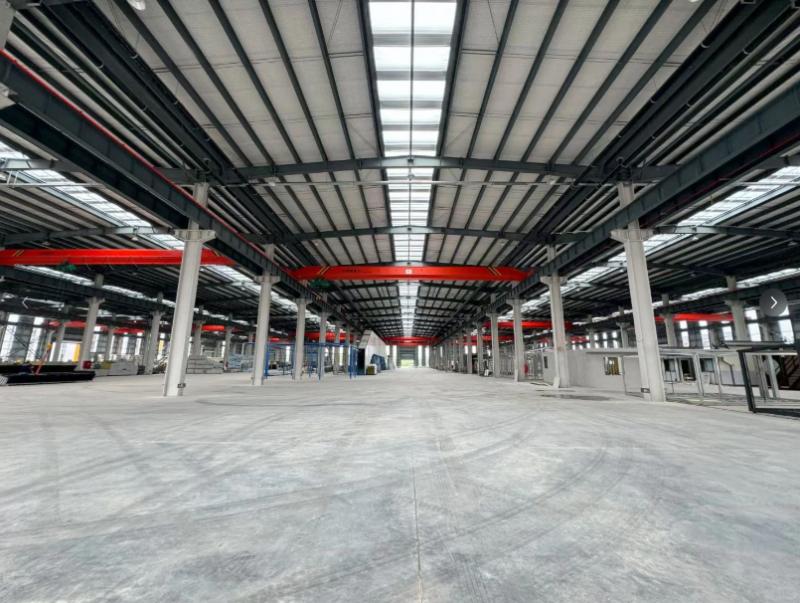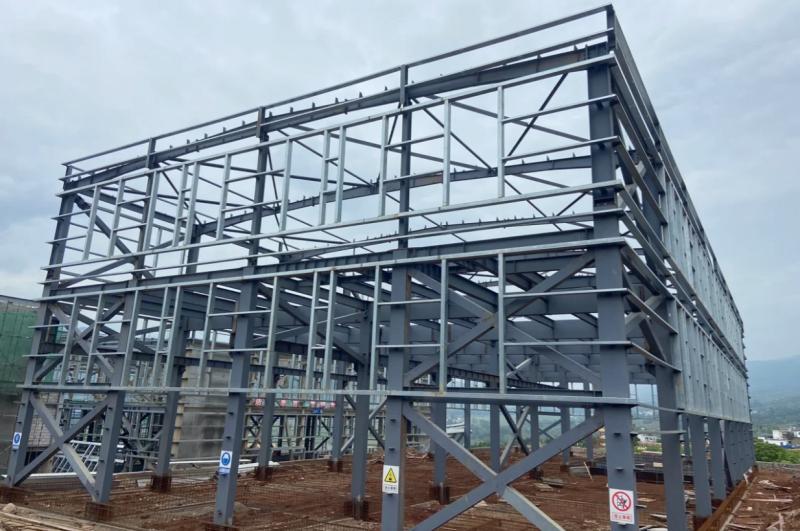How Much Does It Cost to Build a Steel Structure Warehouse

When planning a factory or warehouse, many people's first question is often, "How much will it cost?" In reality, the price of building a steel warehouse isn't a fixed figure.
Generally speaking, the global cost of a steel warehouse ranges from $30 to $90 per square meter.
This difference is due to factors such as warehouse size, design complexity, material grade, location, and labor costs.
If you choose a Chinese steel structure factory, prices can be 30% to 50% lower than in the European and American markets. This is why more and more overseas customers are turning to Chinese manufacturing.

Why are more people choosing steel warehouses?
Steel warehouses are favored for their cost-effectiveness, fast construction, and long lifespan. Compared to traditional concrete warehouses, they are more flexible, durable, and easier to expand.
Steel structures utilize high-strength steel (such as Q235 and Q345) that can withstand strong winds, heavy snow, and earthquakes. Furthermore, modern factories produce components with high precision, increasing installation efficiency by nearly 40% and significantly shortening the overall construction period.
For small and medium-sized enterprises, this means faster commissioning and earlier revenue generation. For large-scale projects, standardized and modular designs make future expansion easier.
Average Cost of a Steel Warehouse
The cost of a steel warehouse isn't a fixed number; it depends on many factors, including materials, design standards, labor, location, and supporting facilities. Below, we'll break down the cost components of each component.
Steel Structure Material Cost (approximately $15–$35/m²)
The "skeleton" of a steel warehouse consists of H-beams, columns, beams, and purlins, accounting for approximately 30%–40% of the total construction cost.
Price fluctuations primarily depend on steel thickness, steel quantity, and whether hot-dip galvanizing is used for corrosion protection.
For example, choosing high-strength Q355 steel and adding an anti-rust coating may increase costs by approximately 10–15%, but the structural durability can be significantly extended.
Roof and Siding Cost (approximately $10–$25/m²)
This component determines the warehouse's insulation, fire resistance, and aesthetics. Common materials include color-coated steel sheets, polyurethane (PU) sandwich panels, EPS (Electronic Polystyrene) boards, or rock wool sandwich panels.
If the warehouse is used to store food, pharmaceuticals, or electronics, rock wool or PU panels are recommended. Although they cost slightly more (up to $25/m²), they significantly improve insulation and fire resistance.
Foundation and flooring costs (approximately $5–$20/m²)
The foundation cost of a steel warehouse is generally significantly affected by soil conditions and load requirements.
Lightweight warehouses can utilize shallow foundations, while large logistics warehouses require reinforced concrete foundations and wear-resistant flooring.
Generally speaking, foundations and flooring account for approximately 15%–20% of the total construction cost. If the foundation is soft or requires reinforcement, the cost can increase by approximately 20%.
Doors, windows, and accessories cost (approximately $3–$10/m²)
Warehouse doors, windows, and accessories are not essential components of the building, but they are directly related to ventilation, lighting, and operational convenience. This includes rolling shutters, skylights, ventilation windows, and drainage systems.
If electric rolling shutters and automatic ventilation systems are used, budget for $8–$10 per square meter.
For standard designs, this expense is generally not significant, but it can lead to better energy efficiency over time.
Labor and Installation Costs (approximately $10–$20 per square meter)
Construction processes include welding, hoisting, and assembly.
In regions with lower manufacturing costs, such as China, labor costs are approximately $10–$15 per square meter.
However, for projects in North America, Europe, or Australia, local labor costs may rise to $25–$40 per square meter.
Selecting an experienced installation team can reduce construction errors and shorten construction timelines, indirectly reducing overall costs.
Overall Cost Range: $30–$90 per square meter
Overall, the overall cost of a steel warehouse typically ranges from $30–$90 per square meter.
This difference is primarily determined by project size, design complexity, material grade, and construction location.
For example:
Economy Warehouse (Simple Structure): $30–$45/m²
Medium Warehouse (Insulation + Standard Features): $50–$70/m²
High-End Warehouse (Fireproofing + Insulation + Automatic Doors + Ventilation): $70–$90/m²
1000 Square Meter Warehouse Cost Estimate
Assuming you plan to build a 1000 square meter standard steel structure warehouse using medium-grade materials and standard features, the total cost will be approximately $35,000–$90,000 USD.
If the project is located in China, the actual cost is usually on the lower end due to lower labor and material costs.
However, if the project is located in Europe or the United States, the total cost may increase by 20%–40% due to shipping, tariffs, and local installation costs.
What Factors Determine the Cost?
When evaluating the construction costs of steel warehouses, many people find significant discrepancies between quotes. However, the key factors that determine cost often lie in structural design, material selection, and construction details.
Below, we analyze the core factors influencing steel warehouse construction costs, focusing on five key areas of concern to users.
1. Warehouse Area and Layout
Warehouse area is the primary factor affecting cost.
The larger the area, the lower the unit cost. This is a typical "scale effect." For example, a 1,000-square-meter warehouse might cost $60 per square meter, while a 5,000-square-meter project can cost an average of $45–$50 per square meter.
The structural form is also crucial.
Single-story warehouses are generally 20%–30% cheaper than multi-story structures, as the latter require a more complex beam-column system, floor supports, and additional safety features.
For clients primarily focused on storage, a single-story, high-rise layout is often the most cost-effective option.
2. Steel Specifications and Anti-Corrosion Treatment
The steel grade and protective treatments determine the durability of a warehouse.
Common steel grades on the market include Q235, Q345, and hot-dip galvanized steel.
Q235 steel: Affordable and easy to work with, suitable for inland areas.
Q345 steel: Higher strength, suitable for medium- to large-scale warehouse structures.
Hot-dip galvanized steel: Strong corrosion resistance, particularly suitable for coastal areas, high humidity, or chemical environments. While anti-corrosion coating and galvanizing increase material costs by approximately 10–15%, they can significantly extend the warehouse's service life by over 10 years.
From a long-term investment perspective, this expense is well worth it.
3. Insulation and Thermal Insulation
Whether a warehouse is insulated is another key factor affecting construction costs.
If a sandwich panel structure (PU, EPS, or rock wool) is used, the overall cost will typically increase by approximately 20%.
However, these materials provide insulation in summer and heat in winter, resulting in significant long-term energy savings, making them particularly suitable for temperature-controlled warehousing, food, or electronics industries.
For example, a standard metal color-coated steel warehouse costs approximately $50 per square meter, while an insulated warehouse using rock wool sandwich panels costs over $65 per square meter.
However, due to the estimated 10–15% energy savings in operational life, most companies still prefer to invest in insulation systems.
4. Geographic Location and Transportation Costs
Geographic location directly determines transportation and labor costs. In regions like the Middle East, Africa, and South America, labor costs fluctuate significantly, and in some areas, infrastructure is insufficient, leading to higher lifting costs.
Sourcing prefabricated steel structural components from China can significantly reduce overall costs.
This is because these components can be standardized, packaged in modular packages, and shipped in containers.
Compared to sourcing raw materials locally, the overall shipping cost of warehouse structures manufactured in China can be reduced by over 30%.
Many international projects choose to partner with Chinese factories (such as WZHbuild) due to their mature export systems, comprehensive logistics chains, and global delivery capabilities.
5. Design Complexity and Functional Requirements
Warehouses aren't always a single shell.
Some companies may request the addition of running beams, mezzanines, offices, or cold storage areas during their designs, all of which directly impact the construction cost. For example:
Adding a running beam requires structural reinforcement, increasing costs by approximately 15%;
Adding a mezzanine or second floor increases construction and material requirements, increasing the overall budget by 20–25%;
Building in an office area or cold storage involves insulation, soundproofing, electrical systems, and other costs, resulting in even greater cost differences.
While these designs increase construction costs, they also improve warehouse space utilization and operational efficiency, making them a valuable investment in the long term.

What Are the Hidden Costs of Steel Warehouses?
During the construction of steel warehouses, many people often focus solely on the "construction cost," overlooking some easily overlooked hidden costs. If these costs are not planned ahead of time, they can easily lead to budget overruns or construction delays. Let's analyze them one by one.
1. Transportation and customs clearance costs
For international projects, transportation costs are crucial.
Steel structural components are typically shipped in containers or bulk, and costs vary depending on the port, transportation method, and distance.
In addition, tariffs and customs fees in the importing country must be calculated in advance to avoid funding gaps during project execution.
For example, for shipments from China to Southeast Asia, container transportation plus tariffs can account for 5%–10% of the total project cost.
2. Equipment rental costs
Although steel structural components are prefabricated in the factory, on-site installation still requires specialized equipment.
Common rental equipment includes:
Crane for lifting large steel beams and roofing components;
Welding machines for on-site welding and reinforcement;
Scaffolding or aerial work platforms for ensuring construction safety.
If equipment rental costs are not considered in advance, the project may incur additional costs ranging from thousands to tens of thousands of dollars, especially for large warehouse construction.
3. Plumbing and Piping
Steel warehouses typically require plumbing, electrical wiring, lighting, ventilation, and drainage systems.
Warehouses for different purposes have different requirements:
Warehousing: Basic lighting and ventilation;
Cold chain warehouses: Complex piping and refrigeration systems;
Industrial production: High power loads require high-voltage wiring.
Failure to account for wiring and piping costs during the design phase will result in additional costs later in construction and may affect the construction schedule.
4. Permits and Project Management Costs
Some regions have strict regulations for warehouse construction, requiring construction permits, environmental approvals, and safety inspections.
In addition, project management costs, including supervision, construction coordination, and quality inspections, are not negligible. These costs typically account for 3%–7% of the total construction cost. Advance planning can avoid approval delays and budget overruns.
How to Reduce Steel Warehouse Construction Costs
When building a steel warehouse, reducing costs doesn't mean sacrificing quality; it can be achieved through scientific planning and optimized operations. Here are several proven cost-control methods:
1. Optimize Structural Design
By reducing unnecessary components and adopting standardized modular designs, welding and installation time can be significantly reduced.
For example, standardizing beam and column specifications and roof panel dimensions not only speeds up construction but also reduces material waste.
Sound design optimization can often reduce overall construction costs by 10%–15%.
2. Select an Experienced Manufacturer
Chinese manufacturers such as WZHbuild have extensive production experience and modern equipment.
They can optimize production processes while ensuring the strength and durability of steel structures, thereby reducing manufacturing costs.
Furthermore, manufacturers often provide one-stop services, including design, production, transportation, and installation support, making the overall project more efficient.
3. Plan Transportation in Advance
Scheduling the packaging and delivery of structural components can save transportation costs. For example, modular packaging of standard components can fully utilize container space and reduce transportation costs by approximately 10%.
Advance planning can also reduce on-site waiting time and expedite construction.
4. Bulk procurement of raw materials
Bulk procurement of steel, color-coated steel plates, or sandwich panels typically yields more favorable unit prices.
Bulk procurement not only reduces material costs but also ensures a stable supply, avoiding construction delays due to material shortages.
5. Prefabrication or modular design
Modular design allows components to be largely fabricated in the factory, requiring only on-site assembly.
This approach shortens construction timelines, reduces labor and on-site errors, and minimizes material waste.
Overall, prefabricated warehouse construction can save 15%–20% compared to traditional on-site construction.
Summary
Steel warehouses, due to their high strength, fast construction speed, and low maintenance costs, have become the preferred storage and production space for many companies. They can meet diverse needs, from large logistics centers to industrial plants to temporary storage facilities, providing reliable structural support at a reasonable budget.
Choosing the right supplier is crucial. As an experienced Chinese steel structure manufacturer, WZHbuild provides one-stop services from design, manufacturing, and installation, ensuring efficient project implementation.
Furthermore, through optimized design, rational material selection, and construction management, we can further reduce costs, shorten construction schedules, and enhance the overall efficiency and competitiveness of the warehouse.




